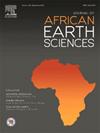Predicting Early Cretaceous deepwater turbiditic successions in the offshore Aaiun-Tarfaya Basin, southern Morocco: constraints from new data from Fuerteventura
IF 2.2
4区 地球科学
Q2 GEOSCIENCES, MULTIDISCIPLINARY
引用次数: 0
Abstract
This paper re-examines the sedimentology and biostratigraphy of the Early Cretaceous Main Clastic Unit (Steiner et al., 1998) exposed in Fuerteventura, and provides a correlation to the proximal equivalent of the system onshore Morocco, to assess the implications for the petroleum system and potential reservoir distribution.
Lower Cretaceous coarse clastic-dominated continental to shallow-marine successions are extensively exposed in the onshore Aaiun-Tarfaya Basin, Morocco. The deep-water distal counterparts of these systems are less well-documented, and only exposed on Fuerteventura, where they have been exhumed by tectonic uplift associated with volcanism. The studied section is dated as pre-late Berriasian based on previous work and the discovery of a well-preserved ammonite as part of this study. It is made of thin bedded clastic turbidites with occasional coarser and thicker bedded intervals exposed in a succession of overturned and sub-vertical outcrops, intruded by igneous bodies, with local repetitions of the succession due to tectonic folding.
Three large-scale cycles can be identified; two coarsening-upward, interpreted to represent the progradation of lower and middle lobes of a large submarine fan and an overall fining-upward cycle with increasing contribution of calciturbidites and limestone beds. The latter is interpreted to reflect the sea-level rise during Aptian and Albian times and the associated development of carbonates on the shelf, resedimented into the deep basin as calciturbidites.
The sand content in the lower part of the three cycles can reach up to 95 %, deposited as high density turbidites. This can be correlated with the low stand wedge seen in seismic, draping the older Jurassic carbonate platform. Detailed logging and new biostratigraphy further constrain understanding of these depositional systems and their evolution, helping to reduce uncertainty in exploration for these important reservoir systems that are targets for offshore exploration.
预测摩洛哥南部近海Aaiun-Tarfaya盆地早白垩世深水浑浊岩序列:来自Fuerteventura新数据的约束
本文重新研究了富埃特文图拉暴露的早白垩世主要碎屑单元(Steiner et al., 1998)的沉积学和生物地层学,并提供了与摩洛哥陆上系统的近端等效的相关性,以评估对石油系统和潜在储层分布的影响。摩洛哥Aaiun-Tarfaya盆地广泛暴露出下白垩统粗大碎屑岩为主的陆相-浅海相序列。这些系统的深水远端对应物没有得到很好的记录,只在富埃特文图拉岛暴露出来,在那里它们是由与火山作用相关的构造隆起挖掘出来的。根据之前的工作和在本次研究中发现的保存完好的菊石,研究部分被确定为贝里亚晚期前。它由薄层状的碎屑浊积岩组成,偶有较粗或较厚的层状间隔暴露在一系列倒转和亚垂直的露头中,被火成岩侵入,由于构造褶皱,局部有重复的序列。可以确定三个大尺度旋回;两次向上粗化,被解释为一个大型海底扇的下叶和中叶的进积,以及一个整体的向上精化旋回,其中钙积岩和灰岩层的贡献越来越大。后者被解释为反映了阿普提亚和阿尔比安时期的海平面上升和陆架上碳酸盐岩的相关发育,并以钙积岩的形式重新沉积到盆地深处。三个旋回下部含砂量可达95%,为高密度浊积。这可能与地震中看到的低立楔盖住了更古老的侏罗纪碳酸盐岩台地有关。详细的测井和新的生物地层学进一步限制了对这些沉积体系及其演化的理解,有助于减少这些重要储层体系勘探的不确定性,这些储层体系是海上勘探的目标。
本文章由计算机程序翻译,如有差异,请以英文原文为准。
求助全文
约1分钟内获得全文
求助全文
来源期刊

Journal of African Earth Sciences
地学-地球科学综合
CiteScore
4.70
自引率
4.30%
发文量
240
审稿时长
12 months
期刊介绍:
The Journal of African Earth Sciences sees itself as the prime geological journal for all aspects of the Earth Sciences about the African plate. Papers dealing with peripheral areas are welcome if they demonstrate a tight link with Africa.
The Journal publishes high quality, peer-reviewed scientific papers. It is devoted primarily to research papers but short communications relating to new developments of broad interest, reviews and book reviews will also be considered. Papers must have international appeal and should present work of more regional than local significance and dealing with well identified and justified scientific questions. Specialised technical papers, analytical or exploration reports must be avoided. Papers on applied geology should preferably be linked to such core disciplines and must be addressed to a more general geoscientific audience.
 求助内容:
求助内容: 应助结果提醒方式:
应助结果提醒方式:


